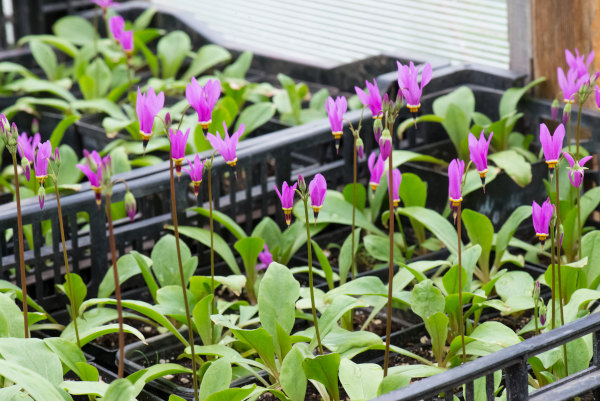How to grow Dodecatheon
Dodecatheon are a section of plants within the Primulaceae family. There are a dozen species in the section. A section in plant botany is a taxonomic rank below genus but above the species and a section has been added as a way of organising very large genera. In the Dodecatheon taxonomy you have the following order.
Family: Primulaceae
Genus: Primula
Subgenus: Primula auriculastrum
Section: Primula Doedecatheon
Species: shown in the Horticultural divisions table below.
Dodecatheon are largely confined to North America and north eastern Siberia. Preferring damp lowland sites up to high mountain meadows of the Rockies. Only a few species are gown in gardens for their showy and unique blooms.
All Dodecatheon are ephemeral - quick to emerge in spring from a basal rosette with large smooth, leathery, primula like leaves, flowering and retreating back to underground dormancy as summer temperatures rise. Also known as summer dormant herbaceous perennials. Plant height ranges from 20cm – 50cm
Their unusual flowers resemble the reflexed petals of a cyclamen. Bare stems arise from the crown atop of which 8-20 flowers hang from the umbel. Each flower containing 5 upward reflexed petals and a cluster of yellow stamen surrounding a single, purplish green style that converge in a downward point. The flowers and its markings resemble a dart.
The release of pollen occurs by ‘buzz pollination’ the protruding stamens are hollow and do not release pollen when brushed. Certain pollinators such as Bumblebees and solitary bees can release the pollen by buzzing their wings against the stamen. Honeybees are unable to do this action.
Pollinated flowers are followed by erect oval to cylindrical mahogany-coloured capsules 1-1.5cm long that contain very fine seeds that are dispersed when wind blows the capsules.
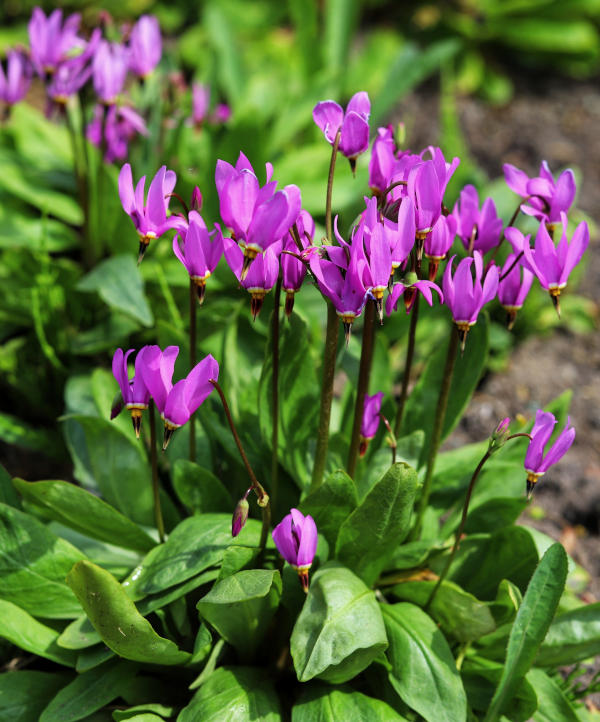
Zantedeschia is a genus of flowering plants from the family Araceae and is native to southern Africa. With a rich history dating back to the Ancient Romans, these deciduous or semi-evergreen perennials have been used as a symbol of celebration. Zantedeschia was Named after Professor Giovanni Zantedeschia, an Italian botanist.
There are two main forms of Zantedeschia: hardy and tender. Hardy forms of the plant can be grown outdoors, enjoy moist soil and full sun or partially shaded conditions - these are known as Arum lilies. Tender forms of Zantedeschia prefer being grown in containers or pots and should be brought inside over the winter - these are known as Calla lilies.
With tuberous flora in all colours from whites, yellows and oranges to deep reds and purples, Zantedeschias are not to be overlooked in any garden, as long as they have sufficient sunlight to grow in.
Ready to learn more about growing Zantedeschia? Read on for all there is to know...

Key Information
Soil pH
Position
Hardiness

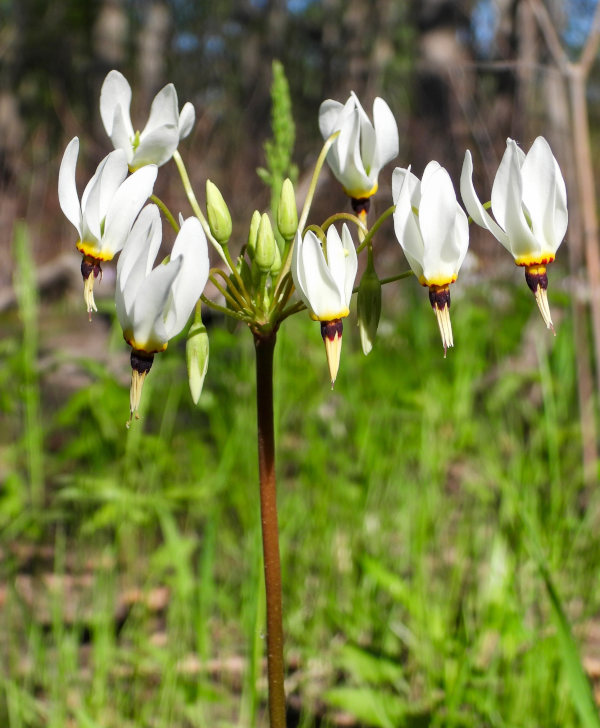
Here we list out the most popularly cultivated species and hybrids available in the U.K.
| Species | Common name |
HARDY – cold winter (H5/ -10°C to -15°C) Grow anywhere in the UK | Dodecatheon austrofrigidum | Frigid shooting star |
Dodecatheon clevelandii | Padre’s shooting star | |
Dodecatheon frenchii | French’s shooting star | |
Dodecatheon frigidum | Western arctic shooting star | |
Dodecatheon hendersonii | Broad-leaved shooting star | |
Dodecatheon jeffreyi | Sierra shooting star | |
Dodecatheon dentatum | White shooting star | |
Dodecatheon meadia | Mead's shooting star | |
Dodecatheon pulchellum | Pretty shooting star |
Where & when to plant Dodecatheon
Position - Dappled Shade / Part Shade / Shade preferring sheltered locations
Soil - Moist free drained humus-rich soil, growing in clay and loam.
Flower - Spring.
Dodecatheon can be planted all year around when purchased grown in pots providing the ground is not frozen or waterlogged.
If container grown plants are planted out during the active summer growing season make sure that they are watered regularly until the plant has settled into its new location. Water at soil level rather than the foliage. Please note that dodecatheon will go dormant in mid-summer. Foliage will collapse and die back to a tuber stored below soil level into the following spring. It is still suitable to plant dormant plants.
Dodecatheon like dappled shade sites with moist rich soil. They are ideal in cottage garden and alpine/rock garden schemes and make useful groundcover plants in borders at the front of border at base of mature roses and shrubs.
How to plant Dodecatheon
- For planting in the garden, dig the soil area removing any large stones and weeds and breaking up any lumps. Mix in some organic matter, ideally leaf mould, though manure or garden compost are also fine. Rake level and firm with your heels. Rake level again.
- Water plants well and allow to drain before planting.
- A good tip is to dig a hole twice the size of the root-ball. Fill with water and allow to drain before placing in the plant which is especially good for summer plantings.
- Remove the plant from its pot placing the plant in the hole, ensuring the top of the root ball sits level with the surface of the soil. Too low and the plant may rot, too high and the roots can dry out.
- Backfill with soil and firm in gently with your foot.
- Soak soil well with water.
- For planting in containers, first choose an appropriately sized pot around 5-7cm larger than the root ball of your plant (you’ll need to gradually increase the pot size every few years). Always ensure there are plenty of drainage holes in the bottom.
- Use a good quality potting compost if you have it and mix with garden soil. Mix in some horticultural grit and, if not already present (check the labelling on the bag) some slow-release fertiliser granules.
- Start by partially filling the pot with compost; enough so that when placed on it the upper surface of the root ball is about 3cm lower than the top of the pot.
- Fill around the plant with compost, firming down with your fingers then adding a little more so it is held tight.
- Pick up the container and lightly tap on the potting bench or ground a few times to help further settle the compost around the plant.
- Soak well with water.
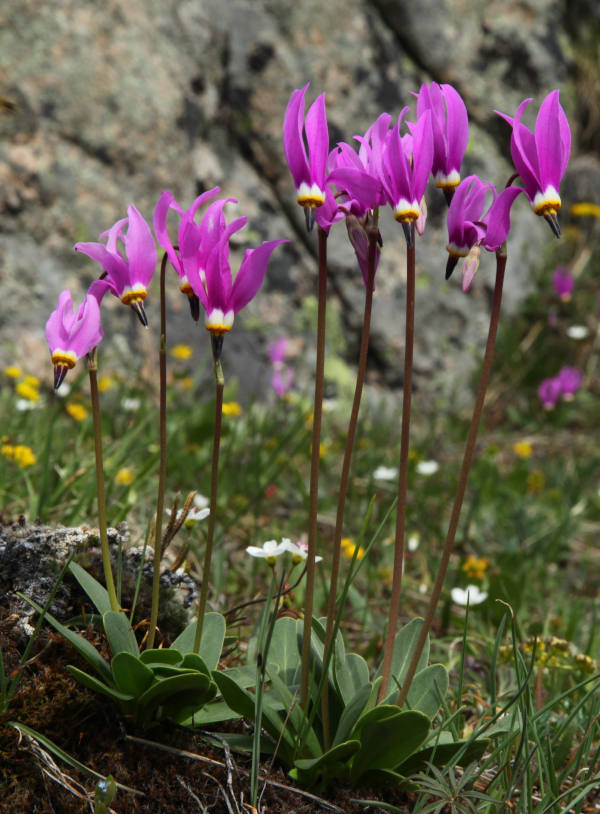
What to plant with Dodecatheon
Outdoors, plant alongside plants with different shaped or coloured foliage as a contrast whilst also making sure nearby plants have interest when dodecatheon are dormant.
Try Delphinium, Ferns and Grasses, Hosta, Helleborus, Ilex, Lupin, Roses, Sarcococca, Tulip, Narcissus (Daffodil) and Viburnum.
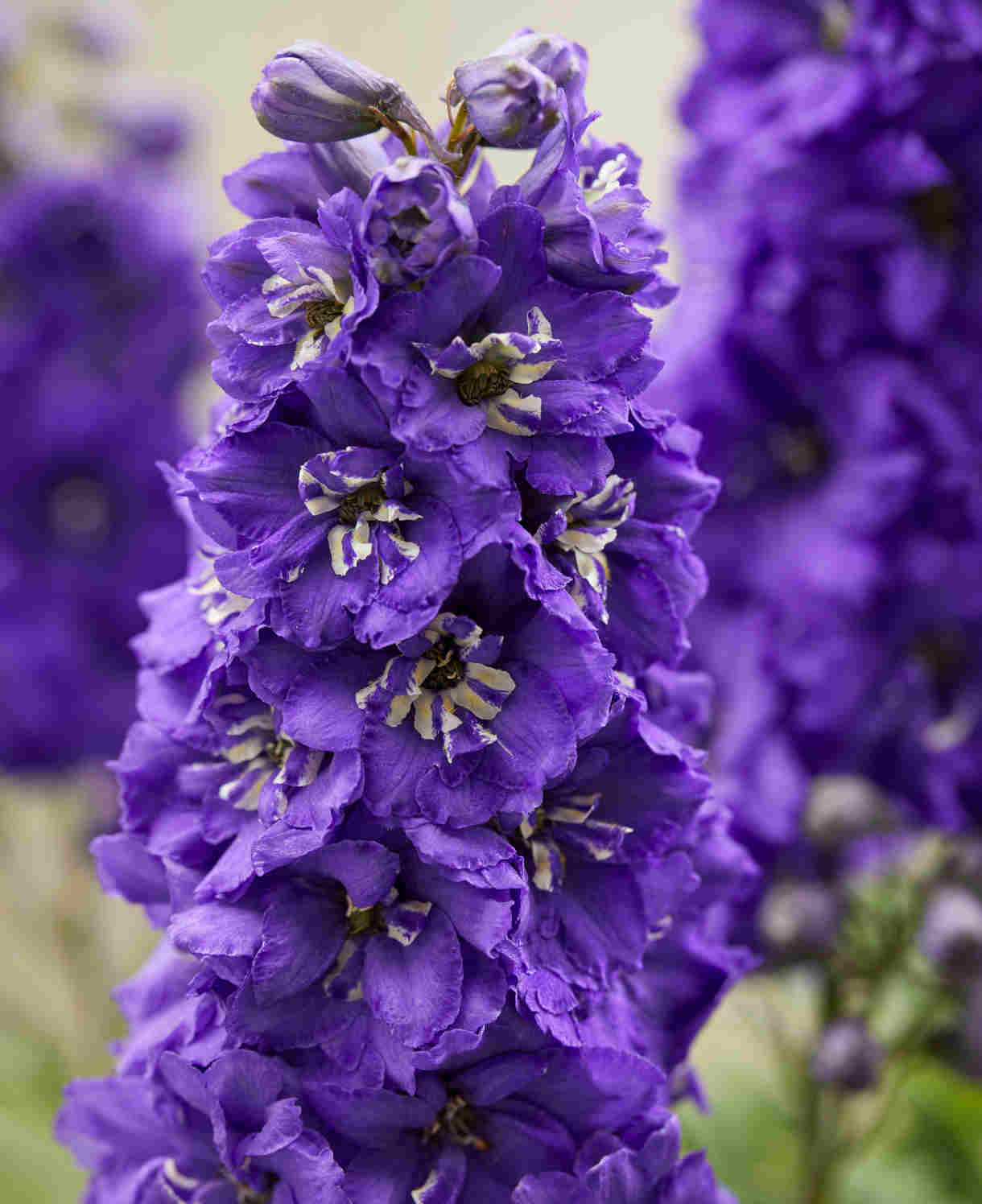

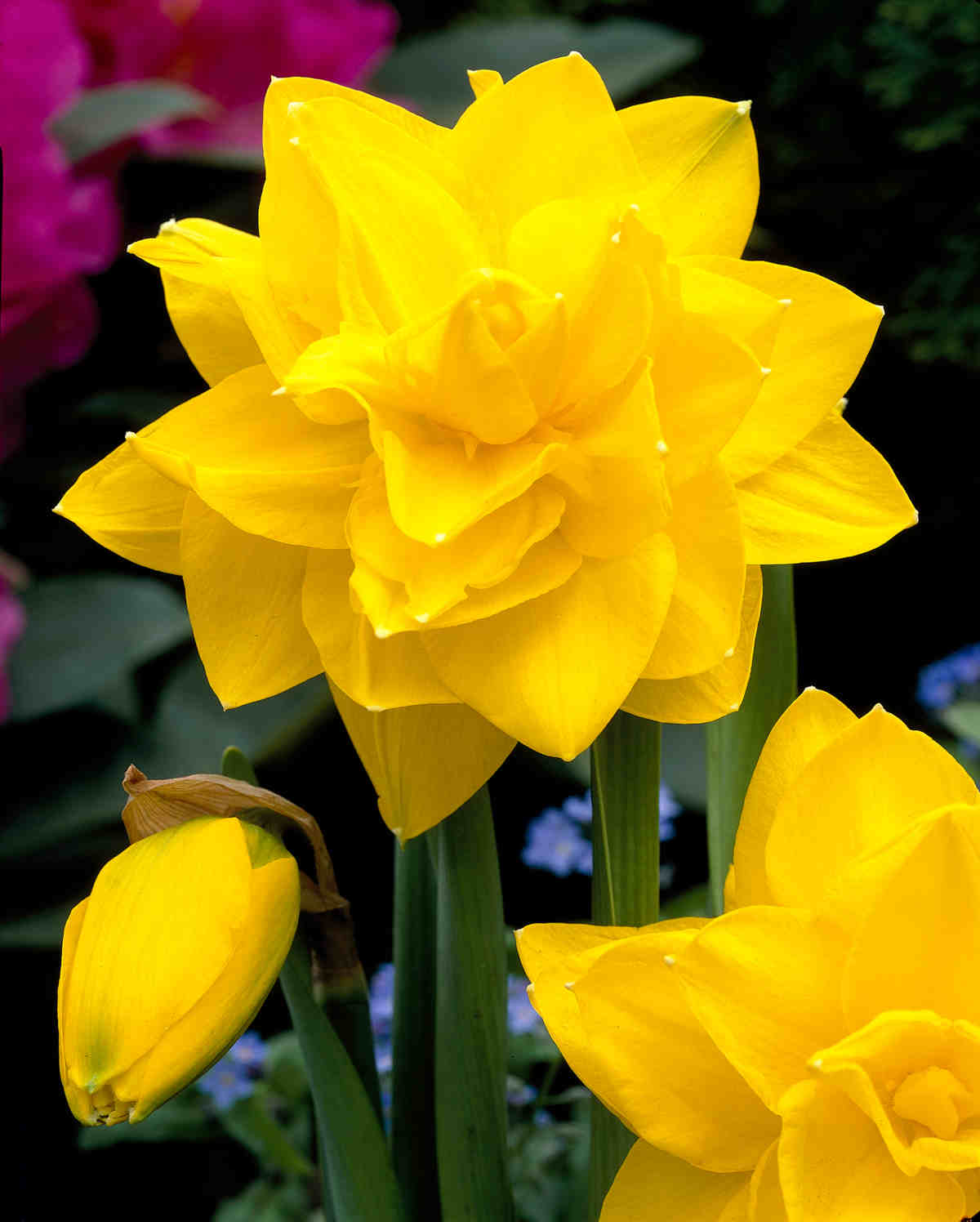
How to care for Dodecatheon
Pruning and Deadheading
Dodecatheon needs no pruning or deadheading. Simply when finished its growing season in early summer gently tidy away decaying growth in autumn.
Watering
On planting outside, they benefit from a good watering in on planting and then regular soakings until established watering the soil not the leaves. After this they should need watering only in very hot, dry conditions. Allowing the top few centimetres to dry out between soakings is a good rule of thumb to avoid overwatering. To check this, wiggle your finger down into the soil until you hit a cool, damp bit.
Feeding
On healthy, fertile soil, a mulch of well-rotted organic matter (i.e., a layer of leaf mould, manure, or garden compost applied to the soil around the plant) should provide enough nutrients for your dodecatheon. This has the added benefit of suppressing weeds and locking in moisture. Mulch when planting, and then again each spring.
If you garden on poor soil or your dodecatheon looks in need of a boost, applying a granular general purpose feed to the surface of the soil and lightly working in can reap benefits. This is known as a top dress and should be done when you’re mulching in spring – first apply the feed, then cover with the mulch.
Container-grown plants are different as they rely solely on the gardener for nutrition. Get off to a flying start by making sure you use a good quality compost with slow-release granules mixed in. These generally provide nutrients for around 6 to 8 weeks, after which you’ll need to apply a liquid feed every 2-3 weeks until the end of the growing season (i.e., July-ish).
Remember to repot your dodecatheon every few years into a slightly larger pot using fresh compost. In-between, it’s worth removing the top few centimetres of compost each spring and replacing with a fresh mix of compost and slow-release granules.
Cold Protection
Dodecatheon are hardy garden plants and should not need any winter protection. Other than ensuring they are not left sitting in water for long periods of time. If container grown, ensure water can get away from the base of container by using pot feet.
Pests and Diseases
Dodecatheon are generally pest free. Some protection against slugs and snails may be required.
How to propagate Dodecatheon
The recommended way to propagate dodecatheon is by root division.
When your plant is at least 3 years old and has been growing well in the previous season you should be able to divide the root structure into more plants.
Dodecatheon are spring flowering but probably best to divide as the leaves are emerging in spring.
- Make sure the plant is not suffering from drought, pest or disease.
- Lift plants as soon as there are signs of new spring leaves emerging. Carefully dig all the way around the plants crown with a fork.
- Shake off excess soil so you can clearly see the roots and emerging leaf clumps.
- Carefully tease and separate the clumps of leaves keeping the entwined roots attached to each clump. Separate into 2 or 3 clumps.
- Either replant the bare root back into the position in the garden as described in Planting in the Garden section or plant clumps into a 1 litre pot as per the instructions for planting into a container
- Water well and leave.
- The dodecatheon should continue to grow and flower this season.
You can also sow seeds of dodecatheon.
- Fill a seed tray with good quality seed compost. Level and firm with the base of another seed tray. Water well.
- Carefully scatter the seeds across the compost surface of the tray
- Cover the seed to their own depth with sand or grit.
- Cover tray with a sheet of glass or cling film to keep humidity within the sowing area.
- Place the seed tray in a light sheltered area at 15-20o Check a couple of times a week for signs of life and to ensure the compost is still moist and not saturated. Germination may take 2-3 months or even wait til spring. Protect against pests such as slugs, and mice.
- Once visible signs of growth can be seen begin hardening off the seedlings by removing glass or cling film for longer periods to allow ventilation. Start from 15 minutes a day and slowly work up to total removal over a couple of weeks. Protect seedlings from winter and spring weather extremes.
- Once seedlings are large enough to handle they can be pricked out individually and grown on.
* Many plants carry Plant Breeders Rights and cannot be propagated for commercial purposes.
Common Dodecatheon questions
Do dodecatheon spread?
Not so much no. Dependant upon variety but a spread of 20cm to 50cm could be achieved.
Do dodecatheon come back every year?
Yes dodecatheon are summer dormant herbaceous perennials. In spring they grow, flower and become fully dormant by mid-summer ready for regrowth the following spring.
Is dodecatheon poisonous?
There are no known toxic effects reported.
